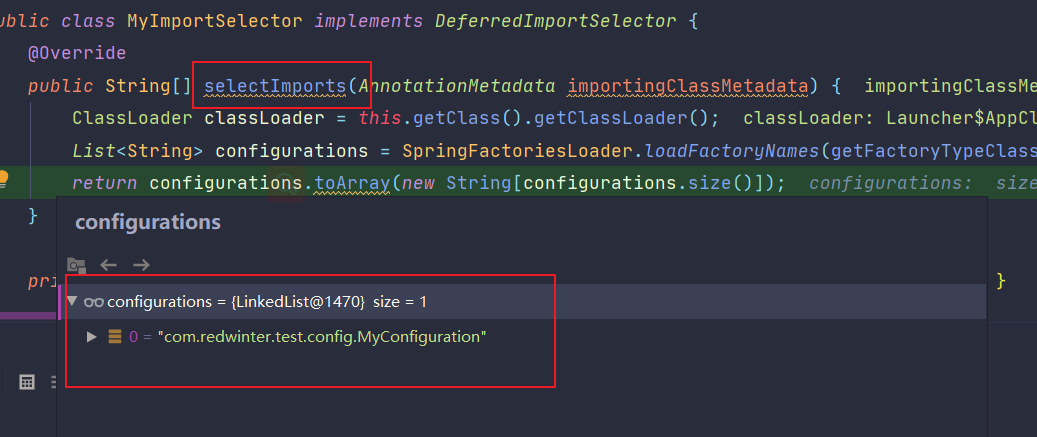Spring 源码(7)Spring的注解是如何解析的?
上一篇 https://www.cnblogs.com/redwinter/p/16196359.html 介绍了BeanFactoryPostProcessor的执行过程,这篇文章介绍Spring中配置的注解是如何通过ConfigurationClassPostProcessor解析的,另外分析下Spring Boot自动装配是如何处理的。
ConfigurationClassPostProcessor 解析了哪些注解?
在上一篇文章https://www.cnblogs.com/redwinter/p/16196359.html 我们知道ConfigurationClassPostProcessor实际上是BeanFactoryPostProcessor的一个实现类,他特殊的地方是他还实现了BeanDefinitionRegisterPostProcessor接口,所以ConfigurationClassPostProcessor 既要实现BeanFactoryPostProcessor的接口方法postProcessBeanFactory也要实现BeanDefinitionRegisterPostProcessor的接口方法postProcessBeanDefinitionRegistry,并且在解析的时候先执行了postProcessBeanDefinitionRegistry方法,再执行了postProcessBeanDefinitionRegistry方法。
接下来我们看看postProcessBeanDefinitionRegistry做了什么?
上源码:
@Overridepublic void postProcessBeanDefinitionRegistry(BeanDefinitionRegistry registry) {int registryId = System.identityHashCode(registry);if (this.registriesPostProcessed.contains(registryId)) {throw new IllegalStateException("postProcessBeanDefinitionRegistry already called on this post-processor against " + registry);}if (this.factoriesPostProcessed.contains(registryId)) {throw new IllegalStateException("postProcessBeanFactory already called on this post-processor against " + registry);}this.registriesPostProcessed.add(registryId);// 处理配置的BeanDefinitionprocessConfigBeanDefinitions(registry);}
整个方法核心是执行了processConfigBeanDefinitions方法,这个方法非常的长并且逻辑也复杂,代码我就不贴了,说一下大概的流程(较详细):
- 先进行合格的
beanDefinition的检查- 获取到注解的元数据信息
- 判断是包含
@Configuration注解,包含则合格,否则判断是否包含了@Component、@ComponentScan、@Import、@ImportResource注解,包含则合格,如果都不包含则不合格
- 对合格的
BeanDefinition排序 - 创建一个解析
@Configuration注解的解析器 - 对合格的
BeanDefinition集合进行解析- 循环解析,最终调用
processConfigurationClass方法 - 判断是否跳过解析,比如配置了
@Conditional注解的 - 调用
doProcessConfigurationClass方法开始解析(下面的解析中可能会存在递归调用)- 解析
@Component注解- 判断是否包含内部类标记了
@Component,比如在标有@Component注解的类里面创建一个内部类也标记了@Component注解,如果有就会进行递归调用processConfigurationClass方法
- 判断是否包含内部类标记了
- 解析
@PropertySources和@PropertySource注解- 比如标记
@PropertySource("classpath:jdbc.properties"),这样就会把这个属性的值全部解析到环境信息的propertySources属性中
- 比如标记
- 解析
@ComponetScans和@ComponentScan注解- 比如配置了扫描的包,那么就会扫描出合格的
BeanDefinition,然后递归解析
- 比如配置了扫描的包,那么就会扫描出合格的
- 解析
@Import注解(Spring Boot自动装配的实现)- 递归解析出标记了
@Import注解的类放在imports属性中 - 解析
ImportSelector接口的实现类 - 调用
ImportSelector#selectImports方法解析需要注册的类 - 递归调用
processImports方法,然后将需要注册的类注册到importBeanDefinitionRegistrars(这里会在后面进行loadBeanDefinition)
- 递归解析出标记了
- 解析
@ImportResource注解- 比如解析配置的
Spring的xml配置文件,最终放到importedResources属性中(后面会进行loadBeanDefinition)
- 比如解析配置的
- 解析
@Bean注解- 比如解析当前类标记了
@Bean的方法 - 然后放在
beanMethods属性中(后面会进行loadBeanDefinition)
- 比如解析当前类标记了
- 解析
- 加载
BeanDefinition从上面解析出来的类中- 循环遍历加载
BeanDefinition - 判断是否跳过,比如实现了
Condition接口的类 - 加载标有
@Bean的BeanDefinition - 加载从
ImportResource中解析的BeanDefinition - 加载从
ImportSelector中配置的解析的BeanDefinition
- 循环遍历加载
- 循环解析,最终调用
整个过程非常复杂,而且存在递归操作,读者可以按照我写的步骤进行debug调试,当然可能会出现到处跳转不知所措的情况,多调几遍就好了,只要知道大致的流程,应该还是不难的。
总的来说就是解析了这些注解:@Component、@PropertySource、@PropertySources、@ComponentScan、@ComponentScans、@Import、@ImportResource、@Bean,然后将标有这些注解的解析成BeanDefinition,如果加上了@Conditionnal注解,那么按照条件进行解析。

自定义自动装配
现在开发都是用SpringBoot,原因在于他非常的方便,引入即可使用,那么他是做到的呢?众所周知Spring Boot有几个注解非常重要,比如:@SpringBootApplication、@EnableAutoConfiguration、@SpringBootConfiguration,其中最重要的是@EnableAutoConfiguration,这个注解里面标记了@Import(AutoConfigurationImportSelector.class),当然还标记了其他的,我们现在只关心这个@Import,里面放入了一个AutoConfigurationImportSelector类。
AutoConfigurationImportSelector类实现了DeferredImportSelector接口,这个DeferredImportSelector接口是ImportSelector的子接口,表示延迟导入的意思。在上面的分析中,其实最主要的是实现他的接口selectImports,直接源码:
@Overridepublic String[] selectImports(AnnotationMetadata annotationMetadata) {if (!isEnabled(annotationMetadata)) {return NO_IMPORTS;}// 获取自动装配的实体AutoConfigurationEntry autoConfigurationEntry = getAutoConfigurationEntry(annotationMetadata);return StringUtils.toStringArray(autoConfigurationEntry.getConfigurations());}protected AutoConfigurationEntry getAutoConfigurationEntry(AnnotationMetadata annotationMetadata) {if (!isEnabled(annotationMetadata)) {return EMPTY_ENTRY;}AnnotationAttributes attributes = getAttributes(annotationMetadata);// 获取合格(候选)的配置List<String> configurations = getCandidateConfigurations(annotationMetadata, attributes);configurations = removeDuplicates(configurations);Set<String> exclusions = getExclusions(annotationMetadata, attributes);checkExcludedClasses(configurations, exclusions);configurations.removeAll(exclusions);configurations = getConfigurationClassFilter().filter(configurations);fireAutoConfigurationImportEvents(configurations, exclusions);return new AutoConfigurationEntry(configurations, exclusions);}protected List<String> getCandidateConfigurations(AnnotationMetadata metadata, AnnotationAttributes attributes) {// 加载配置,根据factoryType,这里的FactoryType就是@EnableAutoConfiguration注解List<String> configurations = SpringFactoriesLoader.loadFactoryNames(getSpringFactoriesLoaderFactoryClass(),getBeanClassLoader());Assert.notEmpty(configurations, "No auto configuration classes found in META-INF/spring.factories. If you "+ "are using a custom packaging, make sure that file is correct.");return configurations;}protected Class<?> getSpringFactoriesLoaderFactoryClass() {// 直接返回@EnableAutoConfiguration 注解return EnableAutoConfiguration.class;}public static List<String> loadFactoryNames(Class<?> factoryType, @Nullable ClassLoader classLoader) {String factoryTypeName = factoryType.getName();// 加载spring.factories文件并解析return loadSpringFactories(classLoader).getOrDefault(factoryTypeName, Collections.emptyList());}private static Map<String, List<String>> loadSpringFactories(@Nullable ClassLoader classLoader) {MultiValueMap<String, String> result = cache.get(classLoader);if (result != null) {return result;}try// 这里获取的url就是:// public static final String FACTORIES_RESOURCE_LOCATION = "META-INF/spring.factories";Enumeration<URL> urls = (classLoader != null ?classLoader.getResources(FACTORIES_RESOURCE_LOCATION) :ClassLoader.getSystemResources(FACTORIES_RESOURCE_LOCATION));result = new LinkedMultiValueMap<>();while (urls.hasMoreElements()) {URL url = urls.nextElement();UrlResource resource = new UrlResource(url);// 读取属性文件,获取到key为EnableAutoConfiguration,value为需要加载的类Properties properties = PropertiesLoaderUtils.loadProperties(resource);for (Map.Entry<?, ?> entry : properties.entrySet()) {String factoryTypeName = ((String) entry.getKey()).trim();for (String factoryImplementationName : StringUtils.commaDelimitedListToStringArray((String) entry.getValue())) {result.add(factoryTypeName, factoryImplementationName.trim());}}}cache.put(classLoader, result);return result;}catch (IOException ex) {throw new IllegalArgumentException("Unable to load factories from location [" +FACTORIES_RESOURCE_LOCATION + "]", ex);}}
所以我们也可以自己写一个进行自动装配,接下来实现一个简单的自动装配。
定义自动装配注解
/*** @author <a href="https://www.cnblogs.com/redwinter/">redwinter</a>* @since 1.0**/@Target(ElementType.TYPE)@Retention(RetentionPolicy.RUNTIME)@Import(MyImportSelector.class)public @interface EnableRedwinterAutoConfiguration {}
创建MyInportSelector类
/*** @author <a href="https://www.cnblogs.com/redwinter/">redwinter</a>* @since 1.0**/public class MyImportSelector implements DeferredImportSelector {@Overridepublic String[] selectImports(AnnotationMetadata importingClassMetadata) {ClassLoader classLoader = this.getClass().getClassLoader();// 加载需要装配的类List<String> configurations = SpringFactoriesLoader.loadFactoryNames(getFactoryTypeClass(), classLoader);return configurations.toArray(new String[configurations.size()]);}private Class<?> getFactoryTypeClass() {return EnableRedwinterAutoConfiguration.class;}}
创建启动类
/*** @author <a href="https://www.cnblogs.com/redwinter/">redwinter</a>* @since 1.0**/@Configuration@EnableRedwinterAutoConfigurationpublic class RedwinterApplication {public static void main(String[] args) {AnnotationConfigApplicationContext context = new AnnotationConfigApplicationContext();context.scan("com.redwinter.test.config");context.refresh();}}
创建需要装配的类
/*** @author <a href=""https://www.cnblogs.com/redwinter/">redwinter</a>* @since 1.0**/@Configurationpublic class MyConfiguration {@Bean@Conditional(RedwinterStrCondition.class)public String myStr() {return "redwinter";}public static class RedwinterStrCondition implements ConfigurationCondition {@Overridepublic ConfigurationPhase getConfigurationPhase() {return ConfigurationPhase.REGISTER_BEAN;}@Overridepublic boolean matches(ConditionContext context, AnnotatedTypeMetadata metadata) {System.out.println("开始匹配。。。");return true;}}}
创建spring.factories文件
com.redwinter.test.config.EnableRedwinterAutoConfiguration=\com.redwinter.test.config.MyConfiguration
启动验证
debug断点:

这就是Spring Boot自动装配的简化版,总得来说我们完成了Spring 对BeanFactoryPostProcessor的执行过程的解析,包括Spring是如何进行注解解析的,其实就是Spring在对BeanDefinition在正式初始化为Bean的前置处理,所以我们可以这个阶段进行很多扩展,比如占位符的处理PropertySourcesPlaceholderConfigurer等。
接下来接续解读AbstractApplicationContext#refresh方法对BeanPostProcessor的注册。
Spring 源码(7)Spring的注解是如何解析的?的更多相关文章
- Spring源码情操陶冶-PropertyPlaceholderBeanDefinitionParser注解配置解析器
本文针对spring配置的context:property-placeholder作下简单的分析,承接前文Spring源码情操陶冶-自定义节点的解析 spring配置文件应用 <context: ...
- Spring源码情操陶冶-AnnotationConfigBeanDefinitionParser注解配置解析器
本文承接前文Spring源码情操陶冶-自定义节点的解析,分析spring中的context:annotation-config节点如何被解析 源码概览 对BeanDefinitionParser接口的 ...
- Spring源码分析-从@ComponentScan注解配置包扫描路径到IoC容器中的BeanDefinition,经历了什么(一)?
阅前提醒 全文较长,建议沉下心来慢慢阅读,最好是打开Idea,点开Spring源码,跟着下文一步一步阅读,更加便于理解.由于笔者水平优先,编写时间仓促,文中难免会出现一些错误或者不准确的地方,恳请各位 ...
- Spring源码解读Spring IOC原理
一.什么是Ioc/DI? IoC 容器:最主要是完成了完成对象的创建和依赖的管理注入等等. 先从我们自己设计这样一个视角来考虑: 所谓控制反转,就是把原先我们代码里面需要实现的对象创建.依赖的代码,反 ...
- 初探Spring源码之Spring Bean的生命周期
写在前面的话: 学无止境,写博客纯粹是一种乐趣而已,把自己理解的东西分享出去,不意味全是对的,欢迎指正! Spring 容器初始化过程做了什么? AnnotationConfigApplication ...
- Spring源码阅读-spring启动
web.xml web.xml中的spring容器配置 <listener> <listener-class>org.springframework.web.context.C ...
- spring源码系列(一)sring源码编译 spring源码下载 spring源码阅读
想对spring框架进行深入的学习一下,看看源代码,提升和沉淀下自己,工欲善其事必先利其器,还是先搭建环境吧. 环境搭建 sping源码之前是svn管理,现在已经迁移到了github中了,新版本基于g ...
- Spring源码:Spring IoC容器加载过程(2)
Spring源码版本:4.3.23.RELEASE 一.加载XML配置 通过XML配置创建Spring,创建入口是使用org.springframework.context.support.Class ...
- Spring源码:Spring IoC容器加载过程(1)
Spring源码版本:4.3.23.RELEASE 一.加载过程概览 Spring容器加载过程可以在org.springframework.context.support.AbstractApplic ...
- 【Spring 源码】Spring 加载资源并装配对象的过程(XmlBeanDefinitionReader)
Spring 加载资源并装配对象过程 在Spring中对XML配置文件的解析从3.1版本开始不再推荐使用XmlBeanFactory而是使用XmlBeanDefinitionReader. Class ...
随机推荐
- lombok的@builder 不能新建DO对象 Lombok存在的一些问题
1. 实体类加上 lombok的@builder之后 就不能新建对象了,,,构造函数被覆盖了? 加上两个标签之后解决 2.Lombok存在的一些问题 lombok问题 @Builder和@NoArg ...
- 你了解过Servlet3.0吗?
Servlet3.0相对于Servlet2.0来说最大的改变是引入了Annotation标注来取代xml配置,用于简化web应用的开发和部署.最主要几项特性: 1. 新增的注解支持:该版本新增了若干注 ...
- 为什么Java不支持运算符重载?
另一个类似棘手的Java问题.为什么 C++ 支持运算符重载而 Java 不支持? 有人可能会说+运算符在 Java 中已被重载用于字符串连接,不要被这些论据所欺骗.与 C++ 不同,Java 不支持 ...
- MyISAM 表格将在哪里存储,并且还提供其存储格式?
每个 MyISAM 表格以三种格式存储在磁盘上: ·".frm"文件存储表定义 ·数据文件具有".MYD"(MYData)扩展名 索引文件具有".MY ...
- Redis 是单进程单线程的?
Redis 是单进程单线程的,redis 利用队列技术将并发访问变为串行访问,消 除了传统数据库串行控制的开销.
- java-注解相关
注解 概念:说明程序的,给计算机看 注释:用文字描述程序 先了解一些怎么正常javadoc文档 1:给类或者方法添加doc注释 2:通过命令javadoc 执行 类.java文件 新建的类: /** ...
- Leetcode刷题之链表增加头结点的前缀节点
链表之增加头结点的前缀节点 在许多链表题中往往需要在题目给的头结点之前增加一个前缀节点 通常在删除链表和头结点需要交换时需要用到这一操作 因为增加这个节点就避免了对删除头结点这种特殊情况的特殊处理 而 ...
- 序列化多表操作、请求与响应、视图组件(子类与拓展类)、继承GenericAPIView类重写接口
今日内容概要 序列化多表操作 请求与相应 视图组件 内容详细 1.序列化多表操作 模型类 models.py中 # 新建django项目 # 创建表 模型类models.py中: from djang ...
- 无单位数字和行高 —— 别说你懂CSS相对单位
前段时间试译了Keith J.Grant的CSS好书<CSS in Depth>,其中的第二章<Working with relative units>,书中对relative ...
- 开源HTML5游戏引擎Kiwi.js 1.0正式发布
Kiwi.js是由GameLab开发的一款全新的开源HTML5 JavaScript游戏引擎.在经过一年多的开发和测试之后,终于在日前正式发布了Kiwi.js 1.0版本. 其创始人Dan Milwa ...
